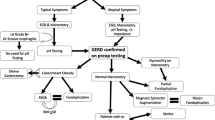Abstract
It is well stated in the literature that medical treatment for peptic ulcer is based on a combination of proton pump inhibitors (PPIs) and antibiotics to eradicate Helicobacter pylori. This treatment is associated with a high rate of immediate success and a low rate of recurrence at 12 months, although it is not effective in all patients. Peptic ulcer (PU) perforation is a serious problem that leads to high complication and mortality rates. Surgical treatment, with its various possibilities, constitutes the ideal treatment. Surgical intervention in these cases, however, can be directed to treating the perforation alone, or it can offer definitive treatment of the ulcer itself. With the hope of establishing why such complications and mortality were seen in the patients in our hospital population, we gathered the facts about PU perforations and the types of surgery performed. We studied 210 consecutive patients (150 men, 60 women) who had undergone surgery at our hospital because of perforation between January 1, 1990 and December 31, 2000. The patients’ median age was 53.0 ± 20.6 years (men 47.7 ± 17.3 years; women 66.3 ± 22.0 years). Altogether, 86 patients had significant associated illnesses, 62 were admitted more than 24 hours after the perforation, and 25 were admitted in shock. We performed resections in 10 patients; 88 patients were treated by suturing the perforation with or without a patch of epiploon; and 112 underwent a troncular vagotomy with drainage (VT + Dr). A total of 21 patients died (10%). Significant risk factors that led to complications were identified by statistical studies. They were a perforation that had been present more than 24 hours, the coexistence of significant associated illnesses, and resection surgery. The significant risk factors that led to death were the presence of shock at admission, the coexistence of significant illnesses, and resection surgery. There was no statistically significant difference concerning morbidity and mortality between simple closure of the perforation and definitive surgery (VT + Dr).
Similar content being viewed by others
References
S Meisner A Sorensen PA Wille-Jorgensen (1993) ArticleTitlePeptic ulcer surgery 1976-1978 and 1986-1988 Ugeskr. Laeger 155 3828 Occurrence Handle1:STN:280:ByuD2sfktlc%3D Occurrence Handle7903009
J Makela S Laitinen MI Kairalouma (1992) ArticleTitleComplications of peptic ulcer disease before and after the introduction of H2-receptor antagonists Hepatogastroenterology. 39 144 Occurrence Handle1:STN:280:By2A3sbpvFM%3D Occurrence Handle1353048
C Svanes (2000) ArticleTitleTrends in perforated peptic ulcer: incidence, etiology, treatment and prognosis World J. Surg. 24 277–283 Occurrence Handle10.1007/s002689910045 Occurrence Handle1:STN:280:DC%2BD3c7is1ChsQ%3D%3D Occurrence Handle10658061
R Walt B Katchinski R Logan et al. (1986) ArticleTitleRising frequency of ulcer perforation in elderly people in the United Kingdom Lancet 1 489 Occurrence Handle1:STN:280:BimC2crotVQ%3D Occurrence Handle2869219
MV Agrez DA Henry S Senthiselvan et al. (1992) ArticleTitleChanging trends in perforated peptic ulcer during the past 45 years Aust. N. Z. J. Surg. 62 729 Occurrence Handle1:STN:280:By2A1M3hsVM%3D Occurrence Handle1520157
MO Jensen MT Bubrick GR Onstad et al. (1985) ArticleTitleChanges in the surgical treatment of acid peptic disease Am. Surg. 51 556 Occurrence Handle1:STN:280:BimD38zosVE%3D Occurrence Handle4051331
A Sonnenberg (1987) ArticleTitleChanges in physician visits for gastric and duodenal ulcer in the United States during 1958-1984 as shown by National Disease and Therapeutic Index (NDTI) Dig. Sci. 32 1 Occurrence Handle1:STN:280:BiiD2sbpsVc%3D
JA Noordijk (1953) ArticleTitlePerforated peptic ulcer: the results of treatment in The Netherlands (1939-50): an analysis of 2551 cases Arch. Chir. Neerl. 5 262–270 Occurrence Handle1:STN:280:CyuD2MbptFQ%3D Occurrence Handle13140002
AM Graves (1933) ArticleTitlePerforated peptic ulcer in German clinics: an analysis of 4402 cases Ann. Surg. 98 197–209
B Bodner ME Harrington U Kim (1990) ArticleTitleA multifactorial analysis of mortality and morbidity in perforated peptic ulcer disease Surg. Gynecol. Obstet. 171 315–320 Occurrence Handle1:STN:280:By6D3MbotFA%3D Occurrence Handle2218836
MV Agrez S Senthiselvan DA Henry (1992) ArticleTitlePerforated peptic ulcer in the Hunter region: a review of 174 cases Aust. N. Z. J. Surg. 62 338–343 Occurrence Handle1:STN:280:By2B2cnnsV0%3D Occurrence Handle1575654
J Boey SKY Choi TT Alagaratnam et al. (1987) ArticleTitleRisk stratification in perforated duodenal ulcers: a prospective validation of predictive factors Ann. Surg. 205 22 Occurrence Handle1:STN:280:BiiD1Mfpt1w%3D Occurrence Handle3800459
W-Y Lau K-L Leung K-H Kwong et al. (0000) ArticleTitleA randomised study comparing laparoscopic versus open repair of perforated peptic ulcer using suture or sutureless technique Ann. Surg. 224 131–138 Occurrence Handle10.1097/00000658-199608000-00004
PH Jordan J Thornby (0000) ArticleTitlePerforated pyloroduodenal ulcers: long term results with omental patch closure and parietal cell vagotomy Ann. Surg. 221 497–488
TT Irvin (1998) ArticleTitleMortality and perforated peptic ulcer: a case for risk stratification in elderly patients Br. J. Surg. 76 215–218
LGM Blomgren (1997) ArticleTitlePerforated peptic ulcer: long-term results after simple closure in the elderly World J. Surg. 21 412–415 Occurrence Handle1:STN:280:ByiB1cfmt1c%3D Occurrence Handle9143574
C Svanes RT Lie K Svanes et al. (1994) ArticleTitleAdverse effects of delayed treatment for perforated peptic ulcer Ann. Surg. 220 168–175 Occurrence Handle1:STN:280:ByuA3s%2FnslI%3D Occurrence Handle8053739
O Bulut C Rasmussen A Fisher (1996) ArticleTitleAcute surgical treatment of complicated peptic ulcers with special reference to the elderly World J. Surg. 20 574–577 Occurrence Handle10.1007/s002689900089 Occurrence Handle1:STN:280:BymB28fhtVY%3D Occurrence Handle8661633
Author information
Authors and Affiliations
Rights and permissions
About this article
Cite this article
Noguiera, C., Silva, A., Santos, J. et al. Perforated Peptic Ulcer: Main Factors of Morbidity and Mortality. World J. Surg. 27, 782–787 (2003). https://doi.org/10.1007/s00268-003-6645-0
Published:
Issue Date:
DOI: https://doi.org/10.1007/s00268-003-6645-0




